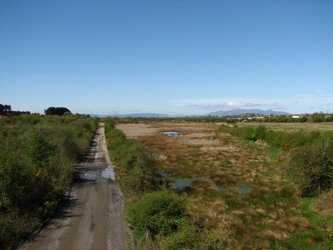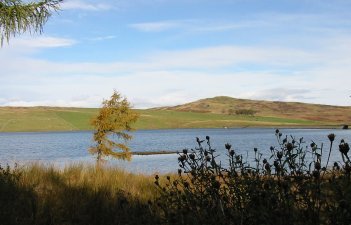Location and Access
Garnock East boasts a wide variety of habitats: an area of mature woodland, consisting mainly of Sycamore, Willow, Ash, and Pine species; a flooded Alder wood; a sizeable area of almost impenetrable Hawthorn/Bramble/Gorse scrub; 8 large ponds and several smaller ones; marshland; extensive sedge and iris beds; a large stretch of estuary; and pockets of rough grassland and heathland.
Formerly owned by ICI, this site was once off limits to the public. However, nowadays people are allowed to walk around the site freely. There are various informal pathways and old industrial tracks to follow.
If travelling by car, one can park in the informal car park beside Bogside Racecourse (NS307400). Follow the old racecourse track northwest and one can access Garnock East from the northwest or southwest corners of the racecourse. If travelling by bus, one can alight beside Irvine Royal Academy. Walk along Sandy Road, crossing the railway (at NS311402) and Bogside Golf Course before reaching the aforementioned car park at NS307400. The Cunninghame Cycleway runs nearest to the site at NS312403.
The Upper Garnock Estuary
Breeding Season
The estuary is at its quietest during late May and June. Shelduck, Eider, and Mute Swan breed along the estuary. There is a large Sand Martin colony in the sand cliffs along the estuary. Common Sandpiper breeds a little bit further upstream. By early June Lapwing are already beginning to congregate for return migration and a sizeable moulting flock of Goosander is starting to build up.
Autumn and Winter
During an autumn high tide, the upper estuary’s saltmarsh is a hive of activity. Several hundred Lapwing roost here along with a few dozen Curlew. Greenshank numbers remain in double figures throughout most of autumn passage and they can usually be seen roosting with the Lapwing on the saltmarsh. Redshank, Dunlin, Oystercatcher, Common Snipe, and Common Sandpiper are some of the more frequently encountered species at low tide; Grey Plover, Golden Plover, Knot, Black-tailed Godwit, Spotted Redshank, Ruff, Curlew Sandpiper, and Little Stint have all been seen on the upper estuary during return passage.
Wildfowl passage is also noticeable during autumn, with small numbers of Pintail, Gadwall, Shoveler, Pink-footed Goose, and Whooper Swan stopping off on migration. By October, large numbers of Teal, Wigeon, and Mallard are present. Goldeneye, Little Grebe, and Red-breasted Merganser are present throughout the winter and small parties of Shoveler and Whooper Swan occasionally drop in. A wide variety of other wildfowl have been seen: Great Crested Grebe, Scaup, Pochard, Tufted Duck, Bewick’s Swan, and American Wigeon have all been recorded on the upper estuary.
During winter, most waders favour Bogside; however, Greenshank shows a distinct preference for the upper reaches of the estuary and this stretch of river supports a significant wintering population. Small groups of Common Snipe can usually be seen roosting or foraging between the saltmarsh and the mudflats.
Garnock East Ponds (NS 299 412)
The ponds support a large (and noisy) breeding population of Water Rail. Little Grebe, Mallard, Moorhen, and several pairs of Mute Swan also breed. There are about 100 territories each of Willow and Sedge Warbler, concentrated around the ponds. Grasshopper Warbler, Reed Bunting, and Whitethroat also breed around the ponds.
Mallard flocks can become quite large during autumn and close inspection sometimes reveals the odd Gadwall. The ponds support surprisingly little in the way of wintering wildfowl. However, a few Tufted Duck, Goldeneye, Mallard, Wigeon, and Teal can usually be found – the latter being particularly fond of the flooded Alder wood.
Garnock East Woods (NS 298 405)
The woodland contains a good variety of breeding birds, including Tawny Owl, Long-eared Owl, Great Spotted Woodpecker, Treecreeper, Long-tailed Tit, Coal Tit, Goldcrest, Blackcap, Chiffchaff, Mistle Thrush, Bullfinch, and Goldfinch. The scrubbier, eastern parts of Garnock East boast Stonechat, Common Whitethroat, and Lesser Whitethroat.
The Garnock East wood is often busy in winter. Flocks of Goldcrest, Treecreeper, and Long-tailed Tit are usually encountered. Goldfinch, Chaffinch, Siskin, and sometimes Redpoll can be found feeding among the Alders. Bullfinch is frequent in the dense scrub at the south east of the site. Great Spotted Woodpeckers are often encountered.
The Garnock East Farm Pool (NS 00 419)
The pool supports breeding Coot, Moorhen, and Mallard. Teal turn up throughout the summer, although breeding hasn’t been confirmed. The pool is good for Green Sandpiper on passage. Garganey and Black-tailed Godwit have also been seen. The pool can be very quiet in winter, but Teal and Wigeon can sometimes be seen and Common Snipe are often flushed.
Notes
- In this article, I give the label Upper Garnock Estuary to the stretch of estuary upstream of the disused McGowan Bridge at NS 99 297.
- A visit to the upper estuary during any phase of the tide cycle can be productive. However, when the tide is at its lowest, the upper estuary becomes a patchwork of silt islands and small creeks/rivulets and birds are often hidden in the contours of the exposed river bed.
- As the tide rises, the flooding saltmarsh becomes a magnet for dabbling ducks. It can be quite a spectacle to see the many hundreds of ducks congregate in such a relatively small area. It is at this time – when the ducks are most active – that you can often pick out rarer ducks that were previously elusive (e.g. that were perhaps hidden in a nook in the saltmarsh or roosting inconspicuously with some Wigeon). But note that high tide isn’t always high enough to flood the saltmarsh.
- During frosty weather, when inland water bodies are frozen, duck numbers inflate significantly and there is a greater chance of encountering some of the more unusual wildfowl species.
- The Garnock East farm pool is usually surrounded by a large number of bulls. Care should be taken when going anywhere near these animals.
- Unlike most of the former ICI grounds, Garnock East is open to the public. It should be noted that the energetics industry is still active across the river on the Ardeer Peninsula, and if, by way of vandalised security fences, one has the opportunity to wander onto the peninsula over one of the old bridges – don’t take it!
![]() Ferry is equipped with lift to transport wheelchair users from car deck to upper deck.
Ferry is equipped with lift to transport wheelchair users from car deck to upper deck.





















